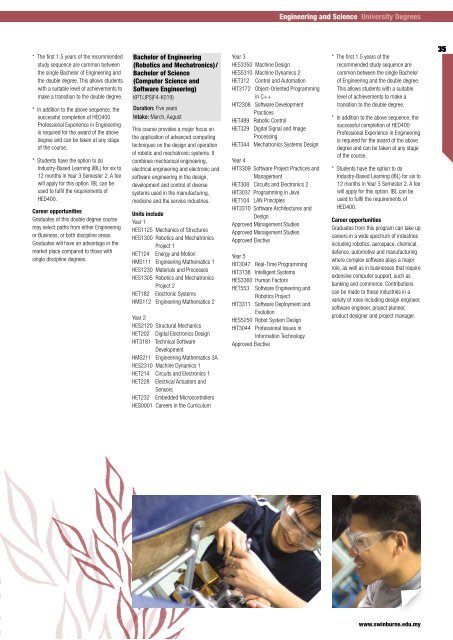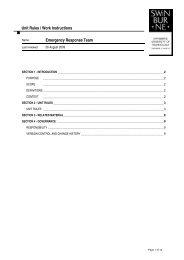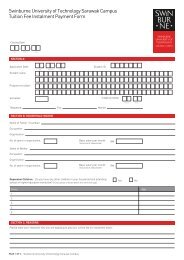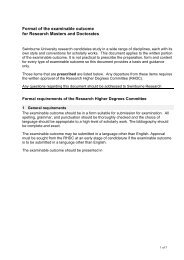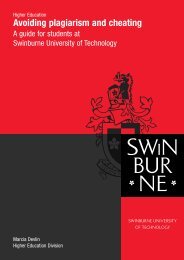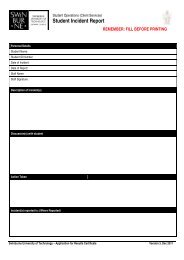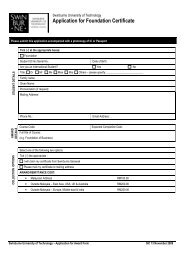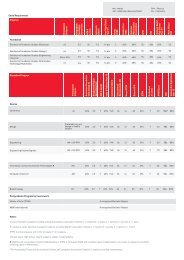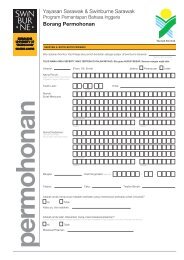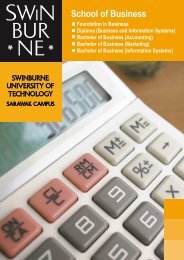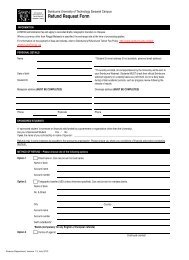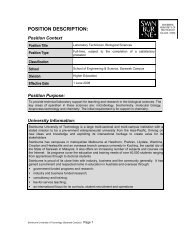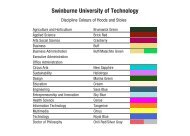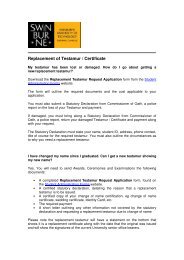Any Questions? - Swinburne University of Technology
Any Questions? - Swinburne University of Technology
Any Questions? - Swinburne University of Technology
Create successful ePaper yourself
Turn your PDF publications into a flip-book with our unique Google optimized e-Paper software.
Engineering and Science <strong>University</strong> Degrees<br />
* The first 1.5 years <strong>of</strong> the recommended<br />
study sequence are common between<br />
the single Bachelor <strong>of</strong> Engineering and<br />
the double degree. This allows students<br />
with a suitable level <strong>of</strong> achievements to<br />
make a transition to the double degree.<br />
* In addition to the above sequence, the<br />
successful completion <strong>of</strong> HED400<br />
Pr<strong>of</strong>essional Experience in Engineering<br />
is required for the award <strong>of</strong> the above<br />
degree and can be taken at any stage<br />
<strong>of</strong> the course.<br />
* Students have the option to do<br />
Industry-Based Learning (IBL) for six to<br />
12 months in Year 3 Semester 2. A fee<br />
will apply for this option. IBL can be<br />
used to fulfil the requirements <strong>of</strong><br />
HED400.<br />
Career opportunities<br />
Graduates <strong>of</strong> this double degree course<br />
may select paths from either Engineering<br />
or Business, or both discipline areas.<br />
Graduates will have an advantage in the<br />
market place compared to those with<br />
single discipline degrees.<br />
Bachelor <strong>of</strong> Engineering<br />
(Robotics and Mechatronics)/<br />
Bachelor <strong>of</strong> Science<br />
(Computer Science and<br />
S<strong>of</strong>tware Engineering)<br />
KPT/JPS(F4-K019)<br />
Duration: Five years<br />
Intake: March, August<br />
This course provides a major focus on<br />
the application <strong>of</strong> advanced computing<br />
techniques on the design and operation<br />
<strong>of</strong> robotic and mechatronic systems. It<br />
combines mechanical engineering,<br />
electrical engineering and electronic and<br />
s<strong>of</strong>tware engineering in the design,<br />
development and control <strong>of</strong> diverse<br />
systems used in the manufacturing,<br />
medicine and the service industries.<br />
Units include<br />
Year 1<br />
HES1125 Mechanics <strong>of</strong> Structures<br />
HES1300 Robotics and Mechatronics<br />
Project 1<br />
HET124 Energy and Motion<br />
HMS111 Engineering Mathematics 1<br />
HES1230 Materials and Processes<br />
HES1305 Robotics and Mechatronics<br />
Project 2<br />
HET182 Electronic Systems<br />
HMS112 Engineering Mathematics 2<br />
Year 2<br />
HES2120 Structural Mechanics<br />
HET202 Digital Electronics Design<br />
HIT3181 Technical S<strong>of</strong>tware<br />
Development<br />
HMS211 Engineering Mathematics 3A<br />
HES2310 Machine Dynamics 1<br />
HET214 Circuits and Electronics 1<br />
HET228 Electrical Actuators and<br />
Sensors<br />
HET232 Embedded Microcontrollers<br />
HES0001 Careers in the Curriculum<br />
Year 3<br />
HES3350 Machine Design<br />
HES5310 Machine Dynamics 2<br />
HET312 Control and Automation<br />
HIT3172 Object-Oriented Programming<br />
in C++<br />
HIT2308 S<strong>of</strong>tware Development<br />
Practices<br />
HET489 Robotic Control<br />
HET329 Digital Signal and Image<br />
Processing<br />
HET344 Mechatronics Systems Design<br />
Year 4<br />
HIT3309 S<strong>of</strong>tware Project Practices and<br />
Management<br />
HET308 Circuits and Electronics 2<br />
HIT3037 Programming in Java<br />
HET104 LAN Principles<br />
HIT3310 S<strong>of</strong>tware Architectures and<br />
Design<br />
Approved Management Studies<br />
Approved Management Studies<br />
Approved Elective<br />
Year 5<br />
HIT3047 Real-Time Programming<br />
HIT3138 Intelligent Systems<br />
HES3360 Human Factors<br />
HET553 S<strong>of</strong>tware Engineering and<br />
Robotics Project<br />
HIT3311 S<strong>of</strong>tware Deployment and<br />
Evolution<br />
HES5250 Robot System Design<br />
HIT3044 Pr<strong>of</strong>essional Issues in<br />
Information <strong>Technology</strong><br />
Approved Elective<br />
* The first 1.5 years <strong>of</strong> the<br />
recommended study sequence are<br />
common between the single Bachelor<br />
<strong>of</strong> Engineering and the double degree.<br />
This allows students with a suitable<br />
level <strong>of</strong> achievements to make a<br />
transition to the double degree.<br />
* In addition to the above sequence, the<br />
successful completion <strong>of</strong> HED400<br />
Pr<strong>of</strong>essional Experience in Engineering<br />
is required for the award <strong>of</strong> the above<br />
degree and can be taken at any stage<br />
<strong>of</strong> the course.<br />
* Students have the option to do<br />
Industry-Based Learning (IBL) for six to<br />
12 months in Year 3 Semester 2. A fee<br />
will apply for this option. IBL can be<br />
used to fulfil the requirements <strong>of</strong><br />
HED400.<br />
Career opportunities<br />
Graduates from this program can take up<br />
careers in a wide spectrum <strong>of</strong> industries<br />
including robotics, aerospace, chemical,<br />
defence, automotive and manufacturing<br />
where complex s<strong>of</strong>tware plays a major<br />
role, as well as in businesses that require<br />
extensive computer support, such as<br />
banking and commerce. Contributions<br />
can be made to these industries in a<br />
variety <strong>of</strong> roles including design engineer,<br />
s<strong>of</strong>tware engineer, project planner,<br />
product designer and project manager.<br />
35<br />
www.swinburne.edu.my


